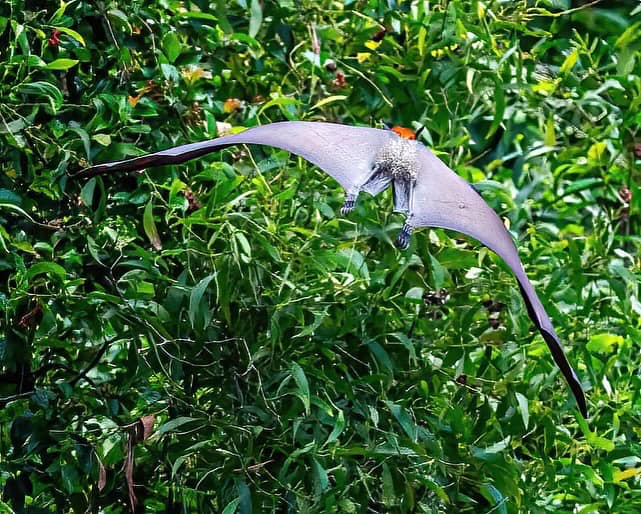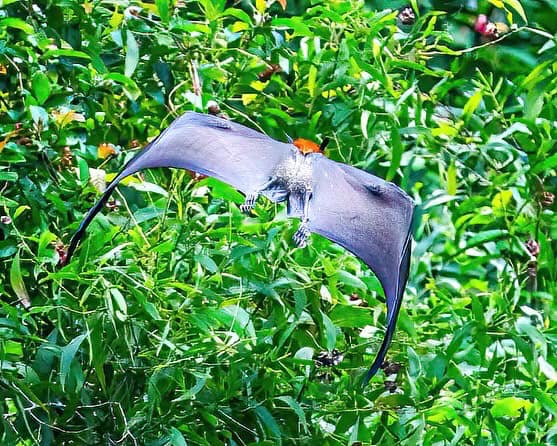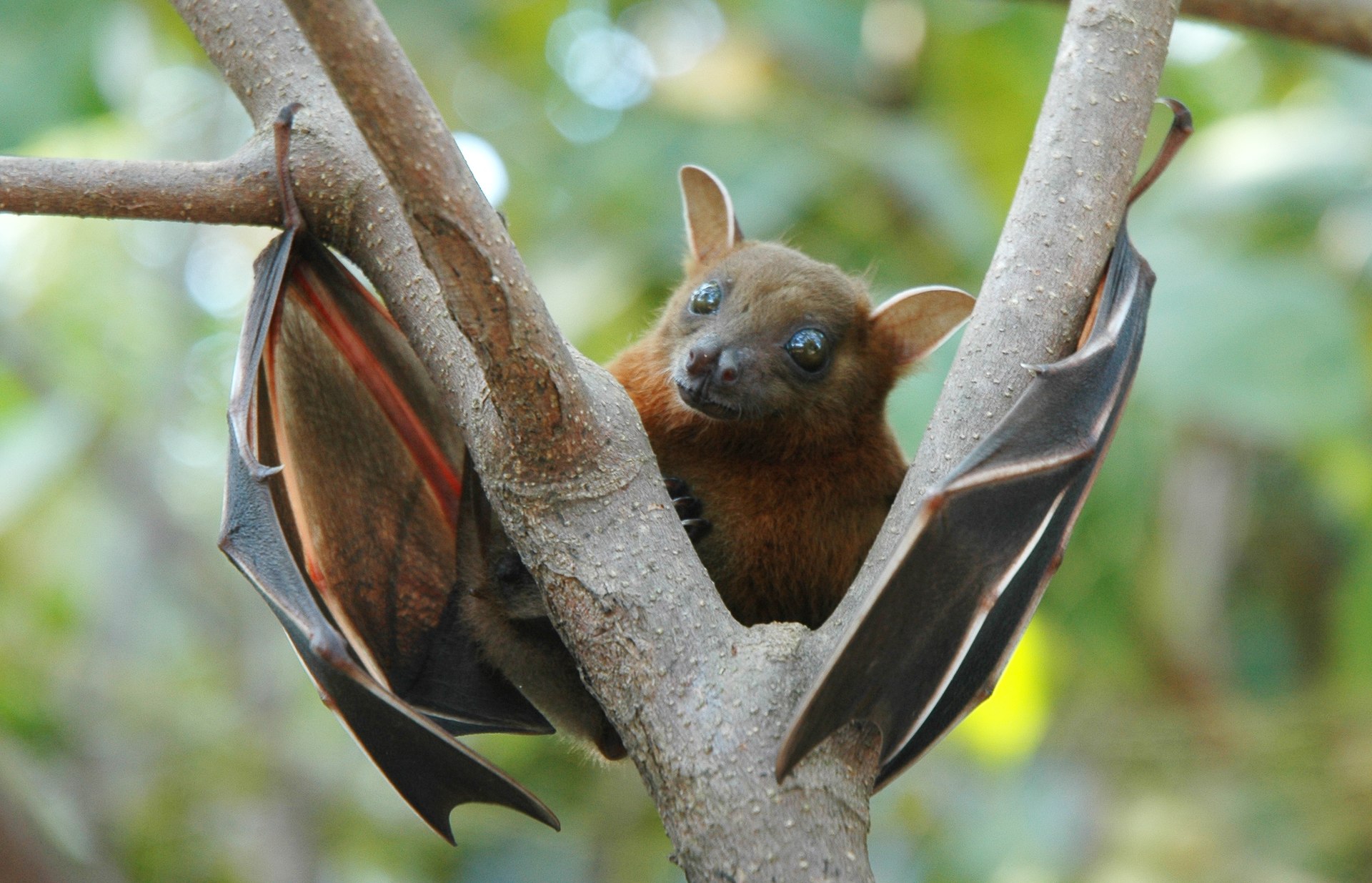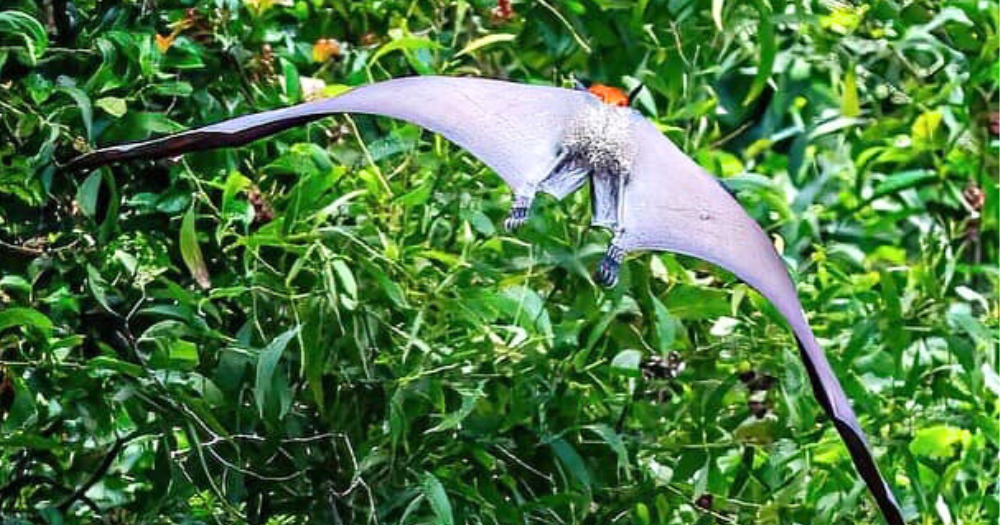Wildlife photographer Andy Chew was visiting Hampstead Wetlands Park on Jun. 25 to shoot the feeding of a juvenile Pacific swallow.
It was there that he and his friend unexpectedly sighted something of the nocturnal variety.
Mystery creature
Chew told Mothership that he happened to catch a glimpse of "something huge flying from one tree to another".
From that brief glance, he was able to gather that this was no typical raptor or bird, as the "overall body shape was different".
Chew said he quickly ran over to the tree to investigate but was unable to locate the mystery creature, and decided to continue photographing other birds in the area.
At around 12pm the same day, Chew was informed by a fellow birder, Dick Tan, that he had managed to spot the huge mystery creature, and was even able to snap some shots of it.
The enigma turned out to be a flying fox, with a wingspan Chew estimated to be over 1m.
 Photo courtesy of Dick Tan
Photo courtesy of Dick Tan
Rare flying fox
Initially unsure of its identity, Chew took to the Facebook group Nature Society Singapore for help with identification.


Most users confirmed the creature was a Malayan flying fox, also known as a large flying fox, one of the largest bats in the world.
It is notable for its size, and can have a wingspan of 1.5m to 1.7m.
N Sivasothi, a biologist and lecturer at the National University of Singapore, revealed in a comment that he saw flying foxes on Pulau Ubin recently as well.

While this species is native to Singapore, sightings of individuals here are a rarity.
In June 2020, an unprecedented sighting of a colony of more than 100 bats were seen flapping over Yishun.
Prior to that, the last recorded sighting of a flying fox in Singapore was at MacRitchie in May 2016, with six individuals sighted.
Have large home ranges
Flying foxes are migratory, and have been known to travel several hundreds of kilometres between roosting sites.
Their home range is large, and encompasses southern Peninsular Malaysia, Singapore and Indonesia.
According to a Singapore Biodiversity Record, the six bats in 2016 were regarded as visitors from neighbouring areas as no flying fox roost was known in Singapore at the time.
In the case of the colony in 2020, Director of Wildlife Management Research, National Parks Board (NParks), Benjamin Lee told Mothership that such a large group could have taken flight in search of food, or due to disturbances in their habitat.
As such, it is uncertain if the bat Chew and Tan saw is roosting here.
Nevertheless, Chew said he is "glad to be able to see it for the first time, and hopefully not the last."
 Photo courtesy of Dick Tan
Photo courtesy of Dick Tan
More common than you think
The Malayan flying fox is classified as "Near Threatened" according to the International Union for Conservation of Nature.
Another common bat species in Singapore is the lesser dog-faced fruit bat.
Although it has similar canine-like features, it is much smaller, with a body length of around 7cm to 8cm.
 Photo from Anton 17 / Wikipedia
Photo from Anton 17 / Wikipedia
Fruit bats are pollinators and seed dispersers, and play an important role in regenerating forests and ensuring their survival.
Some bats feed on insects such as mosquitoes, beetles and crickets, thus helping to keep the insect population in check without the need of pesticides.
Like many wild animals, bats are generally shy and do not attack or show aggression unless they feel threatened.
Members of the public who encounter bats in their living environment should not attempt to feed or get close to the bats.
If they do come into contact with the bats, practise good hygiene by thoroughly washing your hands with soap.
If you come across an injured bat, you can contact Acres at 9783 7782 or NParks at 1800-476-1600.
Top photo courtesy of Dick Tan
If you like what you read, follow us on Facebook, Instagram, Twitter and Telegram to get the latest updates.



